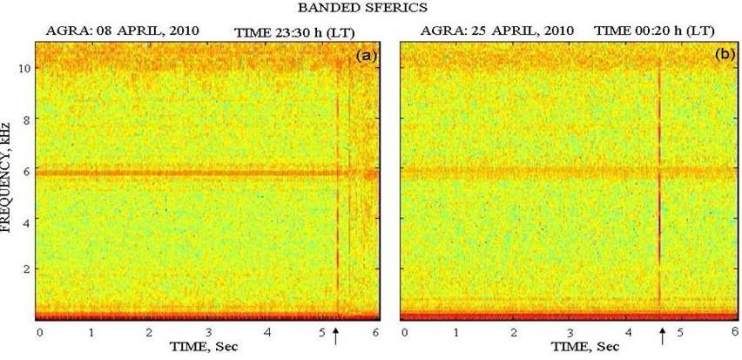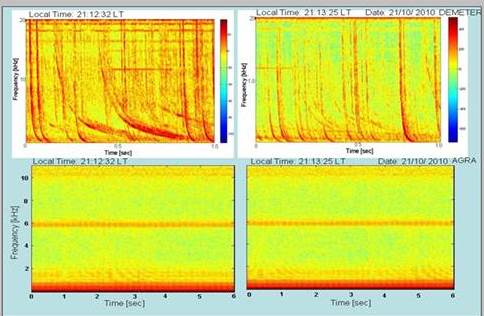Unusual sferics observed at Agra
Employing the experimental setup intended for whistler observations, a large number of unusual sferics have been recorded at the low latitude ground station Agra (Geomagnetic lat.18.09○ N, long. 152.21○ E) during the six months of observations between 01 November, 2009 and 30 April, 2010. The data include banded and narrow band sferics whose occurrences are found to be enhanced occasionally. An example of banded sferics is shown in Fig.1. The results are examined in the light of lightning, solar flare, magnetic storms, and earthquake. The unusual enhancement of all types and those of banded structures are found to correlate positively with X-ray events and magnetic storms respectively. The banded and unusual structures of sferics are interpreted in terms of specular reflection from a slab of enhanced ionization existing at the base of the ionosphere.

Fig.1: Banded sferics (a) regular bands with missing frequencies of about 200 Hz (b) Irregular bands with missing frequencies between 300 and 500 Hz
Satellite and ground observation of whistlers
Very low frequency (VLF) electric and magnetic field data recorded in DEMETER satellite corresponding to 30 nighttime passes over Indian longitudes during the period from 01 September to 09 December, 2010 are analyzed. The quick-look data show the existence of two intense electrostatic noise bands, one high frequency band between 04 and 18 kHz and other low frequency band below 01 kHz in majority of passes. The noise bands are electrostatic because no similar data are seen in the magnetic channel of the satellite. The characteristics of high frequency noise bands are similar to the lower hybrid resonance (LHR) bands observed in earlier satellite experiments. The data also show the occurrence of intense VLF noise bursts of duration two to three hours in the low latitude ionosphere which are analyzed thoroughly and found containing numerous first-hop magnetospherically reflected (MR) whistlers. There are some well-defined large dispersion whistlers also which appear to have propagated to the satellite in hybrid mode of propagation. A comparison with the ground data observed simultaneously at Agra station indicate insignificant and feeble nature of whistlers recorded on the ground suggesting that satellite whistlers propagated in non-ducted mode of propagation and did not reach the ground. Various possibilities for the rare occurrence of VLF bursts are discussed.

Fig.2: Simultaneous satellite (upper panel) and ground observations (lower panel) recorded on 21 October, 2010 at similar durations of time.
